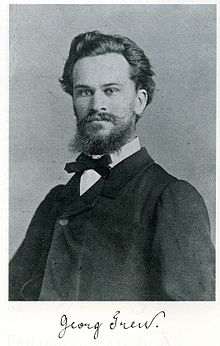Georg Treu
Georg Treu (born March 17 . Jul / 29. March 1843 greg. In Saint Petersburg , † 5. October 1921 in Dresden ) was a classical archaeologist and director of the sculpture collection in the Dresden Albertinum .
Life
From 1861, Treu studied theology in Dorpat and archeology in Berlin . From 1866 he was a research assistant in the antiquities collection of the Hermitage in Saint Petersburg and received his doctorate in Göttingen in 1874 . He then worked as a private lecturer at the University of Berlin and was assistant director at the Royal Museums in Berlin .
During the German excavations of the classical sites in Olympia from 1875 to 1881 Georg Treu was temporarily entrusted with their management. From 1882 to 1915 he succeeded Hermann Hettner as head of the Albertinum's sculpture collection in the former Dresden armory . In this function, he expanded the existing collection by purchasing original Greek sculptures and ancient cabaret and completed this documentation with, for example, antique vases and terracottas. With the dissolution of the Electoral Art Chamber , he integrated its Renaissance and Baroque sculptures. Through close contact with contemporary artists such as Auguste Rodin , Constantin Meunier and Max Klinger , which he several sculptures acquired, he supplemented the collection with examples of modernism and created a new collection focus colored sculptures with examples from antiquity and modernity. In 1891 he opened the cast collection, which served as a model for the founding of the Moscow Pushkin Museum by Ivan Vladimirovich Tsvetaev . In 1894 he set up the "Collection of Original Art Works", which included ancient originals, supplemented by contemporary works. As early as 1900, the Treus Collection was considered a worldwide unique documentation on the history of sculpture.
Treu also worked from 1882 to 1909 as a full professor of art history at the Dresden Polytechnic , where he was also head of the collection for older art history. At the same time he was a professor at the Dresden Art Academy. Georg Treu received an honorary doctorate from the University of Aberdeen in Great Britain in 1906 . In 1913 he received an honorary doctorate from the TH Dresden . Since 1898 he was a full member of the Saxon Academy of Sciences .
Treu died in Dresden in 1921. His grave in the Johannisfriedhof is adorned with a relief by the sculptor Robert Diez . The previously unnamed square between two of his most important places of activity - the Albertinum and the Art Academy building - was named Georg-Treu-Platz in his honor .
Fonts
- Greek clay pots in statuette and bust form , 1875
- Hermes with the Dionysus boy , 1878
- Should we paint our statues? Berlin 1884.
- The sculptures of Olympia in stone and clay , 1894
- Hellenic moods in sculpture , 1910
literature
- Erhard Hexelschneider, Alexander Baranov (ed.): “Building a small Albertinum in Moscow”. Ivan Tsvetaev and Georg Treu in correspondence . Cologne, Böhlau 2006.
- Dorit Petschel : 175 years of TU Dresden. Volume 3: The professors of the TU Dresden 1828–2003. Edited on behalf of the Society of Friends and Supporters of the TU Dresden e. V. von Reiner Pommerin , Böhlau, Cologne a. a. 2003, ISBN 3-412-02503-8 , pp. 974-975.
- Heiner Protzmann: Salome: On polychromy in sculpture: From the correspondence of Max Klinger with Georg Treu . In: Yearbook of the Dresden State Art Collections , 14, 1982, pp. 61–72.
- Heiner Protzmann: Documents on the relationship between Treus and Klinger . In: The Albertinum 100 Years ago, The Georg Treus Sculpture Collection , catalog. State Art Collections, Dresden 1994.
Web links
- Literature by and about Georg Treu in the catalog of the German National Library
Individual evidence
- ↑ Honorary doctoral students of the TH / TU Dresden. Technical University of Dresden, accessed on January 30, 2015 .
- ^ Members of the SAW: Georg Treu. Saxon Academy of Sciences, accessed December 8, 2016 .
| personal data | |
|---|---|
| SURNAME | Faithful, Georg |
| BRIEF DESCRIPTION | German archaeologist, art historian and museum director in Dresden |
| DATE OF BIRTH | March 29, 1843 |
| PLACE OF BIRTH | St. Petersburg |
| DATE OF DEATH | October 5, 1921 |
| Place of death | Dresden |

